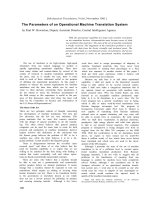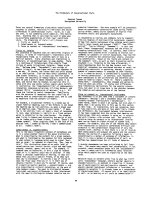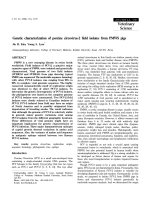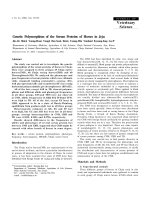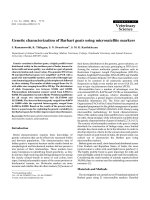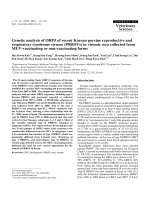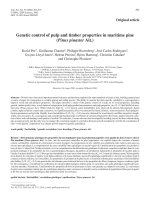báo cáo khoa học: "Genetic parameters of french beef breeds used in crossbreeding for young bull production II. - Slaughter performance" doc
Bạn đang xem bản rút gọn của tài liệu. Xem và tải ngay bản đầy đủ của tài liệu tại đây (922.5 KB, 17 trang )
Genetic
parameters
of
french
beef
breeds
used
in
crossbreeding
for
young
bull
production
II. -
Slaughter
performance
G. RENAND
1.N.R.A.,
Station
de
Génétique
quantitative
et
appliqu!e
Centre
national
de
Recherches
zootechniques
F
78350
Jouy-en-Josas
Summary
Two
sets
of
slaughter
data
at
constant
weight
of
3098
and
699
crossbred
young
bulls
from
199
and
42
sires
of
different
French
beef
breeds,
tested
in
2
stations,
were
used
to
estimate
the
genetic
parameters
of
carcass
criteria
(carcass
yield,
composition,
morphology
and
meat
quality).
Composition
criteria
included
fattening
scores
and
fat
and
muscle
contents
esti-
mated
by
dissection
of
the
11th
rib.
Carcass
morphology
was
estimated
by
carcass
length,
beef
conformation
criteria
(fleshiness
score,
thigh
compactness)
and
by
rib
eye
area.
Meat
quality
was
measured
on
the
longissimus
dorsi
muscle
(shearing
force,
pH
and
water
loss).
Genetic
parameters
were
computed
from
paternal
and
residual
components
of
variances
and
co-
variances
estimated
in
mixed
models
by
H
ENDERS
ON’S
method
3.
Only
dressing
percentage
showed
non-homogeneous
coefficients
of
heritability
between
the
2
data
sets :
.27
and
.69.
Mean
coefficients
of
heritability
were
.27
for
fattening
scores, .27
for
beef
conformation
criteria
and
.51
for
carcass
length.
Coefficients
of
heritability
were
.54
and
.50
for
carcass
fat
and
muscle
contents,
.33
for
rib
eye
area,
.30
for
shearing
force,
.11
for
pH
and
.08
for
water
loss.
The
genetic
coefficients
of
correlation
were
quite
homogeneous
between
the
2
files
for
some
groups
of
variables.
There
were
positive
genetic
relationships
between
live
fleshiness
score
and
beef
conformation
criteria
of
the
carcass
and
between
all
these
criteria
and
dressing
percentage.
Growth
rate
during
fattening
was
slightly
opposed
to
these
criteria
of
beef
conformation
and
yield.
While
in
both
data
sets
fatness
developed
later
in
animals
with
greater
skeletal
development
and
higher
birth
weight,
genetic
correlations
between
carcass
composition
and
the
other
variables
were
different
between
the
2
sets.
However
it
can
be
concluded
that
while
the
simultaneous
improvement
of
growth
potential
and
carcass
beef
conformation
does
not
theoreticaly
require
evaluating
slaughtered
progeny,
it
should
be
done
to
limit
the
probable
increase
of
fatness
precocity
following
such
selection.
Key
words :
Genetic
parameters,
beef
breeds,
slaughter
performance.
Résumé
Paramètres
génétiques
des
races
à
viandes
françaises
utilisées
en
croisement
pour
la
production
de
taurillons
II.
Performances
d’abattage
Deux
fichiers
de
résultats
d’abattage
à
poids
constant
de
3
098
et
699
taurillons
croisés,
descendants
de 199
et
42
pères
de
différentes
races
à
viande
françaises
et
contrôlés
dans
2
stations,
ont
été
utilisés
pour
estimer
les
paramètres
génétiques
des
performances
d’abattage
(rendement,
composition
et
morphologie
de
la
carcasse,
qualité
de
la
viande).
La
composition
de
la
carcasse
est
analysée
à
partir
des
notes
d’état
d’engraissement
et
des
teneurs
en
gras
et
en
muscle
estimées
à
partir
de
la
dissection
de
la
Il’
côte.
La
morphologie
de
la
carcasse
est
appréhendée
par
sa
longueur
et
par
des
critères
de
conformation
bouchère
(note
de
charnure,
compacité
de
la
cuisse
et
de
la
surface
du
muscle
long
dorsal).
Sur
ce
muscle
des
mesures
de
qualité
de
la
viande
ont
également
été
effectuées
(force
de
cisaillement,
pH,
perte
en
eau).
Les
paramètres
génétiques
ont
été
calculés
à
partir
des
composantes
paternelles
et
résiduelles
des
variances
et
covariances,
estimées
dans
des
modèles
mixtes
par
la
méthode
3
d’HENDERSON.
Seul
le
rendement
ne
présente
pas
de
coefficient
d’héritabilité
homogène
entre
les
2
fichiers :
0,27
et
0,69.
Les
coefficients
d’héritabilité
moyens
sont
de
0,27
pour
les
notes
d’état
d’engraissement,
0,27
pour
les
critères
de
conformation
bouchère,
0,51
pour
la
longueur
de
la
carcasse.
Les
coefficients
d’héritabilité
sont
de
0,54
et
0,50
pour
les
teneurs
en
gras
et
en
muscle
de
la
carcasse,
0,33
pour
la
surface
du
muscle
long
dorsal,
0,30
pour
la
force
de
cisaillement,
0,11
pour
le
pH
et
0,08
pour
la
perte
en
eau.
Les
coefficients
de
corrélation
génétique
sont
assez
homogènes
entre
les
2
fichiers
pour
certains
groupes
de
variables.
Il
apparaît
ainsi
des
liaisons
génétiques
positives
marquées
entre
le
pointage
de
la
charnure
en
vif
et
les
critères
de
conformation
bouchère
de
la
carcasse
et
entre
tous
ces
critères
et
le
rendement
à
l’abattage.
La
vitesse
de
croissance
pendant
l’engraissement
est
légèrement
opposée
à
ces
critères
de
conformation
bouchère
et
de rendement.
Alors
que
dans
les
2
fichiers
les
dépôts
adipeux
ont
un
développement
plus
tardif
chez
les
animaux
à
grand
développement
squelettique
et
poids
de
naissance
élevé,
les
corrélations
génétiques
entre
la
composition
des
carcasses
et
les
autres
variables
sont
différentes
entre
les
2
fichiers.
Toutefois
à
la
vue
de
ces
résultats
il
est
possible
de
conclure
que
si
l’amélioration
simultanée
du
potentiel
de
croissance
et
de
la
conformation
bouchère
de
la
carcasse
ne
nécessite
théoriquement
pas
la
réalisation
d’un
contrôle
sur
descendants
abattus,
par
contre
celui-ci
s’avère
nécessaire
pour
limiter
l’augmentation
prévisible
de
la
précocité
des
dépôts
adipeux
à
la
suite
d’une
telle
sélection.
Mots
clés :
Paramètres
génétiques,
races
à
viande,
performances
d’abattage.
I.
Introduction
The
development
of
young
bull
production
in
France
led
some
A.I.
units
to
orient
their
programs
to
the
selection
of
sires
which
would
improve
the
butchery
aptitudes
specific
to
this
type
of
production.
Station
progeny
testing
of
young
bulls
was
developed,
followed
by
their
slaughter
and
carcass
quality
evaluation.
Up
to
now,
no
estimate
of
the
genetic
parameters
of
these
traits
in
the
French
beef
breeds
has
been
available
in
France.
It
is
necessary
to
know
these
parameters
in
order
to
improve
selection
efficiency
and
to
predict
correlated
responses
in
other
traits.
This
latter
aspect
is
highly
important
since
several
professionals
-
the
calf
producer,
calf
feeder
and
butcher
-
are
involved.
The
first
article
on
this
subject
(R
ENAND
,
1985)
estimated
the
genetic
parameters
of
live
performance
from
data
gathered
in
these
progeny
testing
stations.
The
aim
of
the
present
article
is
to
estimate
the
genetic
parameters
of young
bull
slaughter
performance
and
the
relation
between
slaughter
and
live
performance.
These
estimates
should
be
very
useful
to
compare
the
efficiency
of
different
selection
methods
to
improve
meat
production :
performance
or
progeny
testing,
live
or
slaughtered
progenies,
etc.
II.
Material
and
methods
We
used
the
same
animal
material
as
that
for
estimating
live
performance
during
fattening
(R
ENAND
,
1985).
This
material
included
3098
crossbred
young
bulls
in
a
1st
station
(Midatest
A.I.
unit) :
1390
progeny
by
65
Blond
d’Aquitaine
(BA)
sires,
403
progeny
by
36
Charolais
(Ch)
sires,
485
progeny
by
38
Limousin
(Li)
sires,
548
progeny
by
39
sires
of
the
Coopelso
93
(BA
X
Ch
X
Li)
synthetic
sire
line
and
272
progeny
by
21
sires
of
the
synthetic
double
muscled
sire
line
Inra
95
(BA
X
Ch).
Data
on
699
progeny
by
42
Charolais
sires
tested
in
a
2nd
station
(Oger
A.I.
unit)
were
also
analysed.
These
young
crossbred
bulls,
the
progeny
of
dairy
cows
(Frisonne
cows
at
Midatest,
Frisonne
and
Normande
cows
at
Oger),
were
subjected
to
a
high
plane
of
nutrition
in
feedlots
until
a
final
fixed
weight
was
reached.
This
final
weight
increased
markedly
with
the
annual
batches :
515
kg
to
585
and
545
kg,
respectively,
for
the
2
stations.
The
young
bulls
from
the
Midatest
unit
were
slaughtered
in
3
different
commercial
slaughter-houses
and
those
of
Oger
in
only
one.
The
warm
carcasses
were
weighed
less
than
1
hour
after
slaughter.
After
a
half-day
of
chilling,
they
were
scored
and
measured
by
a
single
technician
in
accordance
with
the
E.A.A.P.
recommendation
(D
E
BOER
et
al.,
1974).
For
the
first
5
Midatest
batches,
the
llth
rib
was
taken
the
day
after
slaughter.
After
3
to
4
days
of
refrigeration,
the
rib
was
dissected
into
muscle,
fat
and
bone
and
the
meat
quality
of
the
longissimus
dorsi
muscle
determined.
These
measurements
were
recorded
on
1828
young
bulls :
656
by
34
BA
sires,
215
by
21
Ch
sires,
483
by
38
Li
sires,
310
by
23
Coopelso
93
sires,
and
164
by
17
Inra
95
sires.
Four
different
types
of
information
were
obtained
after
the
young
bulls
were
slaughtered :
-
criteria
of
carcass
morphology :
fleshiness
score
(based
on
15) ;
thigh
compactness
(maximum
width
divided
by
length) ;
rib
eye
area
measured
on
the
section
of
the
11th
rib ;
measurement
of
carcass
length ;
the
first
2
criteria
are
regarded
as
beef
conformation
traits
by
butchers ;
-
carcass
yield :
dressing
percentage
defined
as
the
ratio
warm
carcass
weight/
live
weight
at
end
of
fattening.
This
final
live
weight
was
taken
after
fasting
in
the
morning
of
the
slaughter
day ;
-
composition
criteria :
carcass
muscle
and
fat
contents
estimated
from
results
of
dissection
of
the
llth
rib
and
from
weight
of
perirenal
fat,
according
to
the
formulae
of
R
OBELIN
&
G
EAY
(1975);
scores
(based
on
15)
of
importance
of
the
development
of
subcutaneous
and
channel
fat ;
-
meat
quality
criteria :
shearing
force
measured
by
the
Warner-Bratzler
appa-
ratus ;
ultimate
pH ;
water
retention
capacity
measured
by
relative
weight
loss
during
pressure
of
a
ground
sample
(GO
UT
EF
ONGE
A,
1966).
The
methods
of
statistical
analysis
were
identical
to
those
used
for
computing
the
genetic
parameters
of
live
performance
(R
ENAND
,
1985).
The
components
of
variance
were
estimated
by
applying
method
3
of
H
ENDERSON
(H
ENDERSON
,
1953)
separately
for
both
stations,
and
within
sire-breed
at
Midatest.
An
effect
of
slaughter
house
was
included
in
the
model
for
Midatest
data.
All
the
variables
measured
on
the
carcasses
were
adjusted
for
final
live
weight
differences
since
the
slaughter
decision
aimed
for
a
constant
weight.
III.
Results
and
discussion
A.
Means
and
phenotypic
variability
Among
the
factors
of
variation
included
in
the
models,
we
noted
in
both
data
sets
that
the
calving
parity
of
the
dam
had
no
influence
on
slaughter
performance,
while
the
batch
x
age-group
factor
was
clearly
significant
on
all
variables.
At
Midatest
the
slaugther-house
had
a
marked
effect
on
practically
all
variables.
At
Oger,
maternal
breed
affected
only
the
fat
scores
with
lower
values
for
young
bulls
of
Normande
dams.
Least-squares
means,
standard
deviations
and
coefficients
of
phenotypic
variation
as
well
as
the
coefficients
of
partial
regression
on
final
live
weight
are
shown
in
to
able
1.
Final
weight
significantly
(P !
.01)
affected
most
of
the
variables
except
dressing
percentage
at
Oger
and
2
meat
quality
criteria
(shearing
force
and
pH)
at
Midatest.
The
coefficients
of
partial
regression
observed
were
in
general
coherent
with
biological
phenomena
related
to
animal
weight
gain
(increase
in
size
and
fatness,
reduction
of
muscle
content),
but
they
could
not
be
considered
as
estimators
of
these
changes
due
to
the
decision
to
slaughter
at
constant
weight.
The
coefficients
of
partial
regression
of
dressing
percentage
were
inconsistent
with
the
general
increase
in
this
trait
observed
simultaneously
with
that
of
live
weight.
This
certainly
expressed
the
fact
that
observed
variability
in
final
weight
was
not
entirely
random.
However,
due
to
the
low
values
of
these
coefficients,
adjustment
of
dressing
percentage
to
the
same
final
weight
by
regression
modified
the
estimates
of
these
genetic
parameters
only
slightly,
contrary
to
what
was
found
for
the
morphological
criteria.
In
both
data
sets,
fatness
criteria
showed
the
greatest
phenotypic
variance.
The
coefficient
of
variation
of
the
carcass
fleshiness
score
was
entirely
comparable
to
that
of
the
live
score
(R
ENAND
,
1985),
while
the
coefficient
of
thigh
compactness
was
clearly
lower.
Dressing
percentage,
carcass
length
and
pH
showed
the
least
phenotypic
variability
at
constant
live
weight.
B.
Sire
breed
effects
Apart
from
meat
quality
criteria,
all
the
variables
measured
on
Midatest
carcasses
were
significantly
affected
by
sire
breed.
Differences
in
carcass
morphology
corres-
ponded
to
those
shown
in
young
bulls
before
slaughter.
The
progeny
of
Inra
95
and
Charolais
sires
had
better
beef
conformation
and
shorter
carcasses
than
those
of
Blond
d’Aquitaine
at
the
same
weight.
Classification
according
to
the
rib
eye
area
did
not
follow
exactly
the
same
hierarchy
and
was
closer
to
that
of
dressing
percentage,
where
the
progeny
of
the
double
muscled
sire
line
Inra
95
had
the
highest
values
and
the
progeny
of
the
Limousin
sire
breed
the
lowest.
The
results
of
comparative
studies,
which
included
at
least
2
of
the
sire
breed
types,
showed
that
the
differences
in
dressing
percentage
between
these
sire
breeds
were
low,
with
the
Blond
d’Aquitaine
and
Limousin
having
a
slight
advantage
over
the
Charolais
(A
DAMS
et
al.,
197
3
;
B
IBE et
al.,
1973,
1976 ;
AN
DER
SEN et
al.,
1977 ;
KOCH
&
DI
KEM
AN,
1977 ;
IZ
OBELIN
et
al.,
1978 ;
E
VERITT
et
al.,
1980 ;
BASS et
al.,
1981 ;
FR
EBLING
et
al.,
1982 ;
L
IBO
-
RIUSSEN
et
al.,
1982 ;
M
ENISSIER
et
al.,
1982).
The
carcass
composition
of
crossbred
Blond
d’Aquitaine
progeny
was
clearly
leaner
than
that
of
the
other
sire
breed
types,
even
the
progeny
of
double
muscled
sires
95.
In
contrast,
Limousin
crosses
showed
the
highest
fatness,
certainly
partly
due
to
the
decision
to
slaughter
at
a
fixed
weight.
The
lower
growth
potential
of
these
young
bulls,
as
well
as
their
lower
mature
weight,
resulted
in
a
more
advanced
age
and
stage
of
maturity
at
slaughter
of
Limousin
progeny.
MiQUEr. et
al.
(1974)
observed
similar
results
at
constant
weight.
The
experiments
comparing
breeds
cited
above
and
carried
out
at
a
constant
age
gave
variable
results
between
Charolais
and
Limousin
sire
breeds
while
the
progeny
of
Blond
d’Aquitaine
sires
were
generally
characterized
by
low
fatness.
C.
Heritability
coefficients
Estimates
of
the
coefficients
of
heritability
are
shown
in
table
3.
When
homo-
geneous
estimates
between
the
2
data
sets
were
obtained
for
a
group
of
variables,
a
«
mean
» value
(h
2)
was
calculated
by
weighting
estimates
with
the
corresponding
degrees
of
freedom
of
sire
effect.
Presentation
of
results
is
therefore
simplified.
Estimates
of
the
morphological
criteria
were
homogeneous
between
the
2
data
sets.
The
heritability
of
carcass
beef
conformation
criteria
(fleshiness,
thigh
compactness)
was
h2
=
.27
which
was
not
higher
than
those
obtained
for
fleshiness
score
on
live
bulls
(R
ENAND
,
1985).
Genetic
variability
of
the
rib
eye
area
at
Midatest
(H
2
=
.33)
was
slightly
less
(by
.10
point)
than
the
mean
of
bibliographic
data
at
constant
weight
(R
ENAND
,
1983).
Measurement
of
carcass
length
showed
a
clearly
higher
coefficient
(h-2 =
.51).
This
value
was
also
higher
than
the
heritability
of
the
live
score
of
skeletal
development
(h
2
=
.15,
R
ENAND
,
1985).
Estimates
of
the
coefficients
of
heritability
of
dressing
percentage
were
different
between
the
2
data
sets
(h
2
=
.27
and
.69,
respectively,
at
Midatest
and
at
Oger).
They
agreed
with
the
lowest
and
the
highest
values,
respectively,
in
the
literature
(P
RESTON
&
W
ILLIS
,
1970 ;
R
ENAND
,
1983).
The
lower
value
obtained
at
Midatest
was
certainly
partly
related
to
the
multiplicity
of
slaughter-houses
and
to
a
worse
control
of
the
slaughter
decision.
This
led
to
a
higher
and
not
completely
random
variability
in
final
live
weight
at
Midatest
as
showed
by
its
apparent
coefficient
of
heritability
of
.27,
while
this
coefficient
was
only
.08
at
Oger.
These
results
emphasize
the
difficulty
in
satisfactorily
detecting
the
genetic
variability
of
dressing
percentage.
At
Midatest,
genetic
variability
in
carcass
muscle
and
fat
contents
was
higher
than
found
in
growth
or
beef
conformation
criteria.
The
heritability
coefficients
of
muscle
and
fat
contents
were
h2
=
.50
and
h2
=
.54,
respectively ;
these
were
slightly
higher
(by
.10
point)
than
the
mean
bibliographic
data
available
at
constant
weight
(R
ENAND
,
1983).
In
both
data
sets,
subjective
scores
of
the
development
of
the
sub-
cutaneous
or
channel
fat
showed
homogeneous
but
lower
coefficients
of
heritability
m2 =
.27)
than
those
of
carcass
composition
estimated
from
dissection
of
the
llth
rib.
Thus,
these
scores
did
not
show
all
the
genetic
variability
existing
in
carcass
composition.
Finally,
among
the
meat
quality
criteria
measured
at
Midatest,
only
shearing
force
showed
a
moderate
coefficient
of
heritability
(h
2
=
.30) ;
this
value
was
identical
to
the
mean
of
data
obtained
by
CHRISTIANS
et
al.
(1961),
D
UBOSE
&
C
ARTWRIGHT
(1967),
W
ILS
ON et
al.
(1971,
1976),
D
IN
K
EL
&
BU
SC
H
(1973),
A
NDERSEN
&
L
YKKE
(1977)
and
Keen
et
al.
(1982).
On
the
other
hand,
the
other
2
criteria
do
not
seem
to
be
very
heritable,
at
least
not
under
the
conditions
of
measurement.
The
coefficient
of
heritability
of
water
loss
was
only
h2
=
.08.
For
this
criterion,
G
RAVERT
(1962
a)
and
A
NDERSEN
&
L
YKKE
(1977)
obtained
coefficients
of
.20
and
E
NDER
(1981)
estimates
ranged
between
.18
and
.36
for
different
measurements
of
the
water
retention
capacity
of
longissimus
dorsi
muscle.
The
coefficient
of
heritability
of
ultimate
pH
was
also
low
h2
=
.11.
The
results
in
the
literature
concerning
this
trait
are
rare
and
not
clear.
G
RAVERT
(1962 b)
showed
no
genetic
variability
for
this
trait,
while
E
NDER
(1981)
obtained
a
coefficient
of
.54
for
final
pH
of
longissimus
dorsi
muscle.
D.
Genetic
and
phenotypic
correlation
coefficients
Estimates
of
the
coefficients
of
phenotypic
(rp)
and
genetic
(rg)
correlation
are
shown
in
tables
4
to
7.
These
estimates
were
not
always
homogeneous
between
the
2
data
sets
but,
when
they
were,
a
« mean
value
(r
?
and
rg),
weighted
by
the
number
of
degrees
of
freedom
of
the
model
(r?)
or
of
sire
effect
g)
was
calculated
using
the
Z-transformation
to
simplify
the
following
presentation
of
the
results.
Among
the
criteria
of
carcass
morphology
(table
4),
fleshiness
score
and
thigh
compactness
seemed
to
be
highly
related
phenotypically
and
genetically
(g
=
+
.61
and-
rg
=
+
.74)
and
opposed
to
carcass
length
(r-p
= - .44
and
rs
= - .66).
Live
fleshiness
score
was
closely
related
to
these
two
criteria
(r-p
=
+
.51
and -r,
=
+
.75)
and
opposed
to
carcass
length
(rp
= - .42
and
gr
= - .76).
It
seems
that
the
notion
of
beef
conformation
(development
and
compactness
of
fleshy
tissue)
was
correctly
noted
by
the
scorers
on
the
live
animal
as
well
as
on
the
carcass.
Thus,
it
is
not
necessary
to
slaughter
the
progeny
to
evaluate
bulls
for
this
trait,
and
the
individual
selection
of
bulls
on
their
own
score
would
be
sufficient
to
improve
carcass
confor-
mation.
The
genetic
variability
of
this
beef
conformation
can
be
detected
rather
early,
as
indicated
by
the
coefficients
of
correlation
with
the
fleshiness
score
at
weaning
estimated
at
Oger
(rg
=
+
.74).
Finally,
the
live
score
of
skeletal
development
correlated
less
with
the
criteria
of
carcass
morphology,
especially
at
Midatest :
rg=
+
.18
with
carcass
length
and
rg = - .04
with
the
criteria
of
carcass
beef
conformation
while
genetic
correlations
were :
rg
=
+. 61
and
rg
= - .40
at
Oger.
These
results
and
the
low
heritability
coefficients
of
the
live
score
of
skeletal
development
(R
ENAND
,
1985)
emphasize
its
poor
utility
to
evaluate
carcass
shape
and
size
at
a
constant
live
weight.
The
coefficients
of
genetic
correlation
between
growth
performance
(daily
gain
in
feedlot
and
the
negative
final
age
at
the
end
of
fattening)
and
beef
conformation
criteria
(table
4)
were
slightly
negative :
rg
= - .22
at
Midatest
and f
l
= - .41
at
Oger.
They
confirmed
live
results
(R
ENAND
,
1985)
and
showed
that
simultaneous
genetic
improvement
of
these
2
groups
of
criteria
can
be
obtained
only
by
the
use
of
combined
selection
indexes.
The
genetic
relations
between
birth
weight
and
morphological
criteria
were
much
less
clear.
While
at
Midatest
there
was
inde-
pendence,
at
Oger,
calves
with
high
birth
weight
had
a
slighty
better
beef
confor-
mation
than
the
others.
Among
the
criteria
of
carcass
composition
(table
5),
the
2
fat
scores
were
closely
interrelated
phenotypically
and
genetically
(rp =
+
.66
and
g
=
+
.83).
At
Midatest
they
were
highly
correlated
with
carcass
fat
content
estimated
by
dissection
of
the
llth
rib
(r-p
=
+
.46
and
g =
+
.72).
In
spite
of
these
relationships,
these
subjective
scores are
less
useful
than
dissection
results
to
evaluate
genetic
differences
in
carcass
fatness
due
to
their
lower
heritability
coefficients.
Such
results
and
the
costs
of
the
different
estimates
of
the
carcass
composition
must
be
taken
into
account
in
selection
programs
to
improve
beef
production.
It
should
be
noted
that
the
results
obtained
in
the
USA
showed
that
heritability
coefficients
of
fat
cover
thickness
were
as
high
as
those
of
weight
or
percentage
of
fat
trim
(PRESTON
&
W
ILLIS
,
1970 ;
R
ENAND
,
1983)
and
showed
very
high
genetic
correlations
between
those
fatness
criteria :
bibliographic
mean
rg
=
+
.81
(B
RA
CKE
LS
BERG
81
al.,
1971 ;
I)
INKEL
&
B
USCH
,
1973 ;
D
ICKERSON
Bt
al.,
1974 ;
KocH,
1978 ;
K
OCH
et
al.,
1982).
To
what
extent
these
latter
results
are
related
to
the
animal
material
used
in
the
studies,
which
mainly
consisted
of
British
beef
breeds
characterized
by
high
fatness
(19
to
25
percent
fat
trim)
and
thick
subcutaneous
fat
deposits
(12
to
22
mm
fat
thickness)
is
well
known.
At
Midatest
the
carcass
muscle
content
estimated
by
dissection
of
the
11 th
rib
presented
a
very
strong
opposition
to
fat
content
(rp
= — .95
and
rg
_
- .98)
and
played
a
very
similar
role,
even
though
opposed.
This
genetic
correlation
was
slightly
higher
than
the
coefficients
estimated
by
CUNNIN
GHAM
&
BR
OD
ERICK
(1969),
T
ORREELE
&
S
LAVINSKI
(1970),
A
NDER
SEN
&
LYKKE
(1977)
and
REKL
EWSKI
et
al.
(1980)
at
constant
weight
in
dual
purpose
breeds.
It
would
have
been
interesting
to
estimate
bone
content
because,
while
the
variability
in
carcass
composition
mostly
expressed
variability
in
adiposity,
there
is
some
variability
in
the
composition
of
the
lean
mass
as
expressed
by
high
coefficients
of
heritability
of
the
muscle
to
bone
ratio
(bibliographic
mean
h2
=
.63)
in
the
results
of
ArrnERSErr et
al.
(1974),
A
NDERSEN
&
L
YKKE
(1977)
and
A
LPS et
al.
(1981).
The
coefficients
of
correlation
between
dressing
percentage
and
other
traits
were
of
the
same
sign
in
both
data
sets
and
certainly
expressed
the
same
biological
pro-
cesses.
However,
the
magnitude
of
these
relations
was
greater
at
Oger
than
at
Midatest.
This
might
be
due
to
the
difference
in
genetic
material,
sampling
errors
of
estimated
coefficients
and
also
to
conditions
at
slaughter.
Dressing
percentage
(table
5)
presented
a
genetic
opposition
to
fat
percentage
or
fat
scores
(rg = - .22
and
rs
= — .39
respectively
at
Midatest
and
at
Oger).
Analysis
of
the
bibliographic
results
(R
ENAND
,
1983)
showed
that
at
constant
slaugther
weight,
the
genetic
relations
between
fatness
and
carcass
yield
were
between
about
- .3
and
+
.3
and
that
at
a
constant
age
they
were
slightly
positive.
Genetic
improvement
of
dressing
per-
centage
would
seem
to
go
along
with
a
reduction
in
bone
content
(K
RA
USSLICH
et
al.,
19!0 ;
T
ORREELE
&
S
LAVINSKI
,
19!0 ;
A
NDERSEN
&
L
YKKE
,
1977)
without
any
large
changes
in
fatness.
Dressing
percentage
(table
6)
presented
a
slight
genetic
opposition
to
carcass
length
(r,
= —
.10
and
r,
= — .49
respectively
at
Midatest
and
at
Oger)
and
a
positive
correlation
with
the
criteria
of
carcass
beef
conformation
(rg
=
+
.32
and
rg =
+ .87
respectively
at
Midatest
and
at
Oger).
At
Midatest
the
genetic
coefficient
of
correlation
between
dressing
percentage
and
the
rib
eye
area
(rg
=
+
.47)
was
very
close
to
estimates
obtained
in
the
Hereford
breed
by
S
HELBY
et
al.
(1963),
Dirrx
EL
&
Busc
H
(1973)
(bibliographic
mean
rg =
+
.45)
but
was
lower
than
estimates
obtained
in
dual
purpose
breeds
by
KRX
USSLICH
et
al.
(1970),
A
NDERSEN
&
L
YKKE
(1977)
(bibliographic
mean
r!
=
+
.64).
High
positive
relation-
ships
of
dressing
percentage
with
live
fleshiness
score
were
found
at
Oger
(rg
=
+
.61)
but
not
at
Midatest
(rg
=
+
.03).
Finally,
the
dressing
percentage
(table
6)
was
geneti-
cally
opposed
to
growth
potential
during
fattening
(rg
= — .23
and
rg
= — .53
at
Midatest
and
at
Oger),
while
bibliographic
data
indicate
independence
between
these
2
traits
or
at
least
slight
genetic
opposition
at
constant
slaughter
weight
(R
ENAND
,
1983).
On
the
other
hand,
birth
weight
showed
a
notable
positive
relation
with
dressing
percentage
at
Oger
(rg
=
+
.33)
but
not
at
Midatest
(rg
=
+
.07).
Contrary
to
the
preceding
results,
estimates
of
the
coefficients
of
correlation
between
carcass
composition
criteria
and
the
other
traits
were
of
the
same
sign
in
both
data
sets
only
for
some
groups
of
variables
(table
6).
Greater
skeletal
development
score
was
genetically
associated
with
slightly
lower
fatness
(rg
= — .25).
This
relation
certainly
expressed
later
maturity
in
these
large
sized
bulls.
Birth
weight
showed
a
slight
genetic
opposition
to
adiposity
criteria
(r!
_
-
.30).
Coefficients
estimated
by
A
NDERSEN
&
L
YKKE
(1977)
and
Keen
et
al.
(1982)
also
showed
that
high
birth
weight
was
related
to
slightly
lower
carcass
fatness.
These
results
confirm
that
prenatal
growth
includes
important
biological
processes,
not
only
as
regards
postnatal
growth
potential
but
also
in
relation
to
the
relative
development
of
tissues
and
maturity.
The
relations
between
the
criteria
of
adiposity
and
growth
during
fattening
or
beet
conformation
differed
clearly
between
the
2
data
sets.
While
the
absence
of
a
relationship
between
growth
and
adiposity
at
Midatest
(fg
_
-
.05)
was
compatible
with
most
bibliographic
data
indicating
independence,
or
even
genetic
opposition,
between
these
traits
at
constant
weight
(R
ENAND
,
1983),
the
positive
relation
estimated
at
Oger
(r!
=
+
.42)
differed
from
bibliographic
expectation.
A
more
exact
estimate
of
carcass
composition
is
needed
in
this
station
to
clarify
this
relationship.
The
carcass
fleshiness
score
seemed
independent
of
fatness
criteria
at
Midatest
(r
-
, =
+
.07)
and
slightly
opposed
at
Oger
(tg
= — .28).
This
difference
could be
partly
explained
by
the
different
genetic
material
in
the
2
stations.
A
study
of
these
genetic
intra-type
relations
at
Midatest
showed
that
there
was
a
slight
opposition
between
these
traits
in
Charolais
and
Limousin
sire
breeds,
while
this
relation
was
clearly
positive
in
Blond
d’Aquitaine.
The
variability
of
these
results
confirms
the
difficulty
of
using
fleshiness
scores
for
estimating
muscle
or
fat
content
(K
EMPSTER
et
al.,
1982)
because
they
are
more
related
to
variations
in
amount
of
flesh
(muscle
+
fat)
relative
to
skeleton
than
to
variations
in
the
composition
of
the
flesh
(muscle
v.
fat)
(D
UMONT
,
1977 ;
Du-
MONT
et
al.,
1980).
In
France
fleshiness
is
still
of
economic
importance
because
car-
casses
with
heavy
meat
mass
are
valued
higher
by
butchers.
Finally,
compared
to
relations
with
carcass
fleshiness,
relations
of
fatness
criteria
with
live
fleshiness
score
(r-,
=
+
.53
and
ig = — .07
respectively
at
Midatest
and
at
Oger)
showed
that
the
judgement
of
the
scorer
was
more
influenced
by
the
fattening
state
when
he
scored
the
live
animal
than
when
he
scored
the
carcass.
The
three
criteria
of
meat
quality
measured
at
Midatest
were
genetically
inde-
pendent
of
each
other
while,
phenotypically,
water
loss
decreased
as
the
pH
increased
7).
The
genetic
coefficients
of
correlation
between
these
criteria
and
carcass
fat
content
showed
that
a
selection
against
fatness
should
result
in
an
increase
in
pH
(rg
= - .51),
and
in
water
loss
(rg
= - .35).
Thus,
except
for
a
slightly
favorable
effect
on
tenderness
(rg
=
+
.21
with
shearing
force)
selection
against
excessively
fat
carcasses
would
slightly
lower
meat
quality.
IV.
Conclusion
This
study
completes
data
on
the
genetic
parameters
of
beef
aptitude
criteria
in
the
French
beef
breeds
used
in
crossbreeding.
Apart
from
meat
quality
criteria,
genetic
variability
in
slaughter
performance
appeared
to
be
rather
high.
But
only
part
of
this
variability
was
detectable
when
subjective
evaluation
criteria
were
used
instead
of
measurements
or
weights
and
when
conditions
of
measurements
were
not
sufficiently
monitored.
The
most
frequent
objective
of
beef
aptitude
selection,
under
French
economic
conditions,
is
to
simultaneously
improve
growth
rate
and
carcass
confor-
mation ;
the
estimated
genetic
parameters
of
this
study
indicate
that
this
aim
may
be
achieved
by
selecting
sires
on
their
growth
rate
and
fleshiness
socre
in
performance
testing
stations.
But
such
a
selection
will
be
accompanied
by
correlated
increase
in
early
adipose
deposits.
This
maturing
precocity
will
be
more
evident
when
a
restriction
is
applied
on
birth
weight
due
to
negative
genetic
relations
between
birth
weight
and
fatness.
In
the
production
of
young
meat
bulls
in
France,
where
increase
in
carcass
weight
is
desired
without
increasing
fat
content
at
slaughter,
such
a
simple
selection
method
is
not
enough.
It
would
be
useful
to
test
slaughtered
progeny
and
include
carcass
composition
data
in
the
selection
criteria
to
avoid
the
probable
increase
in
fatness
precocity.
Acknowledgements
G.
R
ENAND
wishes
to
acknowledge
both
A.I.
units
(Midatest
and
Oger)
and
J.
G
AILLA
RD
(LT.E.B.)
for
providing
these
date
and
Mrs
D
AIFUKU
for
translating
the
manuscript
into
English.
Received
April
3,
1984.
Accepted
July
27,
1984.
References
A
DAMS
N.J.,
G
ARRETT
W.N.,
E
LINGS
J.T.,
1973.
Performance
and
carcass
characteristics
of
crosses
from
imported
breeds.
J.
Anim.
Sci.,
37,
623-628.
ALPS
H.,
M
ATZKE
P.,
A
VERDUNK
G.,
1981.
Schatzung
des
Fleisch-
und
Knochen-
gewichtes
im
Schlachtk6rper
von
Jungbullen
der
Nachkommenprufung
an
Stationen.
Z.
Tierz.
Ziichtungsbiol.,
98,
197-209.
A
NDERSEN
B.B.,
F
REDEEN
H.T.,
W
EISS
G.M.,
1974.
Correlated
response
in
birth
weight,
growth
rate
and
carcass
merit
under
single-trait
selection
for
yearling
weight
in
beef
Shorthorn
cattle.
Can.
J.
Anim.
Sci.,
54,
112-125.
A
NDERSEN
B.B.,
L
IBORIUSSEN
T.,
KO
USGAARD
K.,
B
UCHTER
L.,
1977.
Crossbreeding
experiment
with
beef
and
dual-purpose
sire
breeds
on
Danish
dairy
cows.
3.
Daily
gain,
feed
conversion
and
carcass
quality
of
intensively
fed
young
bulls.
Livest.
Prod.
Sci.,
4,
19-29.
A
NDERSEN
B.B.,
L
YKKE
Th.,
1977.
Growth,
feed
utilization,
carcass
quality
and
meat
quality
in
Danish
dual-purpose
cattle.
Beret.
fra
Statens
Husdyrbrugsfors.,
453,
Landhus-
holdningsselskabets
forlag,
Copenhagen.
BASS
J.J.,
CARTER
A.H.,
J
OHNSON
D.L.,
BAKER
R.L.,
J
ONES
K.R.,
19H1.
Sire
breed
comparison
of
carcass
composition
of
steers
from
Angus
dams.
J.
Agric.
Sci.,
97,
515-522.
B
IBE
B.,
F
REBLING
J.,
M
ENISSIER
F.,
1973.
Schema
d’utilisation
des
races
rustiques
en
croisement
avec
des
races
à
viande.
25th
annual
meeting,
E.A.A.P.,
Vienna,
Septem-
ber
23-26,
1973,
26
p.
roneo.
B
IBE
B.,
F
REBLING
J.,
M
ENISSIER
F.,
VIS
SAC
B.,
1976.
Utilisation
des
races
rustiques
en
croisement
avec
des
races
à
viande :
exemple
de
la
race
Gasconne.
Ann.
Genet.
Sél.
Anim.,
8,
233-264.
B
RACKELSBERG
P.O.,
K
LINE
E.A.,
W
ILLHAM
R.L.,
HAZEL
L.N.,
1971.
Genetic
parameters
for
selected
beef-carcass
traits.
J.
Anim.
Sci.,
33,
13-17.
CHRISTIANS
C.J.,
H
ENRICKSON
P.L.,
M
ORRISON
R.D.,
CHAMBERS
D.,
S
TEPHENS
D.F.,
1961.
Some
factors
affecting
tenderness
of
beef.
J.
Anim.
Sci.,
20
(Abstr.).
C
UNNINGHAM
E.P.,
BRO
DE
R
IC
K
T.,
1969.
Genetic
and
environmental
parameters
of
growth
and
carcass
traits
in
dual
purpose
cattle.
Ir.
J.
Agric.
Res.,
8,
397-416.
DE
BOER
H.,
D
UMONT
B.L.,
P
OMEROY
R.W.,
W
ENIGER
J.H.,
1974.
Manual
on
E.A.A.P.
reference
methods
for
assessment
of
carcass
characteristics
in
cattle.
Livest.
Prod.
Sci.,
1,
151-164.
DICKERSON
G.E.,
KONzi
N.,
C
UNDIFF
L.V.,
KOCH
R.M.,
AR
T
HAU
D
V.H.,
GREGORY
K.E.,
1974.
Selection
criteria
for
efficient
beef
production.
J.
Anim.
Sci.,
39,
659-673.
D
INKEL
C.A.,
BuscH
D.A.,
1973.
Genetic
parameters
among
production
carcass
composition
and
carcass
quality
traits
of
beef
cattle.
J.
Anim.
Sci.,
36,
832-846.
D
UBOSE
L.E.,
C
ART
w
RIG
HT
T.C.,
1967.
Relationships
among
production
and
carcass
traits
in
cattle.
J.
Anini.
Sci.,
26
(Abstr.).
D
UM
O
NT
B.L.,
1977.
Relations
entre
la
conformation
et
la
composition
des
carcasses
de
bovins.
Ann.
Zootech.,
26,
125-129.
D
UMONT
B.L.,
D’H
ERLINCOURT
A.,
L
EFEBVRE
J.,
1980.
Composition
anatomique
et
morpho-
logique
des
carcasses
des
bovins.
Proc.
26th
Eur.
Meet.
of
Meat
Res.
Work.,
Colorado
Spring.,
31
August -
5
September
1980,
vol.
A,
260-263.
E
NDER
K.,
1981.
Genetische
Aspekte
zur
Fleischbeschaffenheit
beim
Rind.
Tierzucht,
35,
207-210.
E
VERITT
G.C.,
JURY
K.E.,
DALTON
D.C.,
L
ANGRIDGE
M.,
1980.
Beef
production
from
the
dairy
herd.
4.
Growth
and
carcass
composition
of
straightbred
and
beef-cross
Friesian
steers
in
several
environments.
!V.Z.
J.
Agric.
Res.,
23,
11-20.
F
REBLING
J.,
B
ONAITI
B.,
B
IBE
B.,
G
ILLARD
P.,
M
ENISSIER
F.,
R
ENAND
G.,
1982.
Comparisons
between
fattening
and
slaughter
performance
of
Charolais,
Limousin,
Maine-Anjou
and
Hereford
breeds
according
to
various
production.
2nd
World
Congress
on
Genetics
applied
to
Livestock
Prodavction,
Madrid,
4-8
October
1982,
8,
334-339,
Editorial
Garsi,
Madrid.
G
OUTEFONGEA
R.,
1966.
Etude
comparative
de
différentes
m6thodes
de
mesure
du
pouvoir
de
retention
de
la
viande
de
porc.
Am
2.
Zootech.,
15,
291-295.
G
RAVERT
H.O.,
1962 a.
Untersuchungen
uber
die
Erblichkeit
von
Fleischeigenschaften
beim
Rind.
1.
Fliiche
des
Muse.
long.
dorsi,
Wassergehalt,
Wasserverbindung,
Fettgehalt.
Z.
Tierz.
Ziichtungsbiol.,
78,
43-74.
G
RAVERT
H.O.,
1962 b.
Untersuchungen
iiber
die
Erblichkeit
von
Fleischeigenschaften
beim
Rind
2.
Eiweissgehalt,
pH-Wert,
Farbe,
Muskel
Faserstarke,
Zartheit.
Z.
Tierz.
Ziichtungsbiol.,
78,
139-178.
H
ENDERSON
C.R.,
1953.
Estimation
of
variance
and
covariance
components.
Biometrics,
9,
226-252.
KEMPS
TER
A.J.,
CU
THBE
RT
SON
A.,
HA
RR
INGT
ON
G.,
1982.
Carcass
evaluation
in
livestock
breeding,
production
and
marketing,
306
p.,
Granada,
London.
KocH
R.M.,
1978.
Selection
in
beef
cattle.
3.
Correlated
response
of
carcass
traits
to
selection
for
weaning
weight,
yearling
weight
and
muscling
score
in
cattle.
J.
Anim.
Sci.,
47,
142-150.
KocH
R.M.,
C
UNDIFF
L.V.,
GREGORY
K.E.,
1982.
Heritabilities
and
genetic,
environmental
and
phenotypic
correlations
of
carcass
traits
in
a
population
of
diverse
biological
types
and
their
implications
in
selection
programs.
J.
Anim.
Sci.,
55,
1319-1329.
KocH
R.M.,
D
IKEMAN
M.E.,
1977.
Characterization
of
biological
types
of
cattle.
4.
Carcass
wholesale
cut
composition.
J.
Anim.
Sci.,
45,
30-42.
KRAUSL
I
CH
H.,
AVERDUNK
G.,
GO
TTSCHA
LK
A.,
S
CH
M
IT
TER
W.,
SCHUMANN
H.,
SCHWARZ
E.,
1970.
Die
Besamungszucht
beim
Rind
in
Bayern.
Bayer.
Landw.
Jahrbuch,
47,
3-85.
LIBOR
I
USSEN
T.,
LA
UR
I
TZEN
F.,
AN
DERS
EN
B.B.,
BU
CH
TE
R
L.,
SORENS
EN
S.E.,
KLASTRUP
S.,
K
OUSGAARD
K.,
1982.
(Krydnings
-
og
produktions
-
forsog
med
europaeiske
kodracer
1
og
2)
(in
Danish).
Beret
fra
Statens
Husdyrbrugsfors.,
527,
Landhusholdningsselskabets
forlag,
Copenhagen.
M
ENISSIER
F.,
S
APA
J.,
F
OULLEY
J.L.,
F
REBLING
J.,
B
ONAITI
B.,
1982.
Comparison
of
different
sire
breeds
crossed
with
Friesian
cows :
preliminary
results.
C.E.C.
seminar,
Dublin,
April
13-15,
1981,
More
O’Ferral
G.J.
(ed.),
Beef
production
from
different
dairy
breeds
and
dairy
beef
crosses,
94-137,
M.
Nijhoff,
The
Hague.
MI
Q
UEL
M.C.,
C
AVA
ND
OLI
H.E.,
S
KIADARE
S
SI
R.M.,
M
OLINUEVO
H.A.,
JO
ANDET
G.E.,
P
ARODI
J.J.,
C
ASAL
J.J.,
L
OPEZ
-S
AUBIDET
C.,
B
IDART
J.B.,
1974.
Evaluaci6n
de
reses
de
cruzamientos
de
razas
no
traditionales
con
vientre
Aberdeen-Angus.
Prod.
Anim.,
5,
190-208.
P
RESTON
T.R.,
W
ILLIS
M.B.,
1970.
Intensive
beef
production.
567
pp.,
Pergamon
Press,
Oxford.
R
EKLEWSKI
Z.,
K
ARLOWICZ
W.,
CZLON!KOWSKA
M.,
J
ANKOWSKI
W.,
1980.
(Estimation
of the
breeding
value
of
bulls
as
regards
their
meat
performance,
on
the
basis
of
measurements
of
correlated
traits)
(in
Polish).
Prace
i Materialy
Zootechniczne,
23,
31-45.
R
ENAND
G.,
1983.
Analyse
de
la
variabilité
de
la
croissance
et
de
ses
composantes
chez
les
bovins,
consequences
pour
l’amelioration
génétique
des
aptitudes
boucheres.
These
Docteur-Ingénieur
sciences
agronomiques,
LN.A.,
Paris-Grignon.
R
ENAND
G,
1985.
Genetic
parameters
of
French
beef
breeds
used
in
crossbreeding,
for
young
bull
production.
1.
Live
performance.
Ggng
t.
S81.
Evol.,
17,
153-170.
R
OBELIN
J.,
G
EAY
Y.,
BoNAITI
B.,
1978.
Genetic
variations
in
growth
and
body
composition
of
male
cattle.
C.E.C.
seminar,
Ghent,
October
11-13,
1977,
DE
BOER
H.,
MARTIN
J.
(ed.),
Patterns
of
growth
and
development
in
cattle,
443-461,
M.
Nijhoff,
The
Hague.
R
OBELIN
J.,
G
EAY
Y.,
1975.
Estimation
de
la
composition
des
carcasses
de
jeunes
bovins
a
partir
de
la
composition
d’un
morceau
monocostal
pr6lev6
au
niveau
de
la
11°
cote.
1.
Composition
anatomique
de
la
carcasse.
Ann.
Zootech.,
24,
391-402.
SH
ELB
Y
C.E.,
HA
RV
EY
W.R.,
C
LA
RK
R.T.,
Q
UESENBERRY
J.R.,
WOO
DWARD
R.R.,
1963.
Estimates
of
phenotypic
and
genetic
parameters
in
ten
years
of
Miles
City
R.O.P.
steer
date.
J.
Anim.
Sci.,
22,
346-353.
T
ORREELE
G.,
S
LAVINSKI
T.,
1970.
A
study
about
the
relationships
between
growth
rate,
dressing
percentage
and
carcass
composition
for
intensively
fattened
young
bulls.
Med.
Fac.
Lanbouwwet.
Risjks
Univ.
Gent
Belgium,
35,
401-408.
WI
LS
ON
L.L.,
STOUT
J.M.,
Z
IEGLER
J.H.,
S
IMPSON
M.J.,
V
ARELA
-A
LVAREZ
H.,
R
UGH
M.C.,
W
ATKINS
J.L.,
1971.
Heritability
of
live
and
carcass
characters
in
a
crossbred
beef
herd.
J.
Heredity,
62,
123-125.
W
ILSON
L.L.,
MCC
URLEY
J.R.,
Z
IEGLE
R
J.H.,
W
ATKINS
J.L.,
1976.
Genetic
parameters
of
live
and
carcass
characters
from
progeny
of
Polled
Hereford
sires
and
Angus -
Holstein
cows.
J.
Anim.
Sci.,
43,
569-576.
